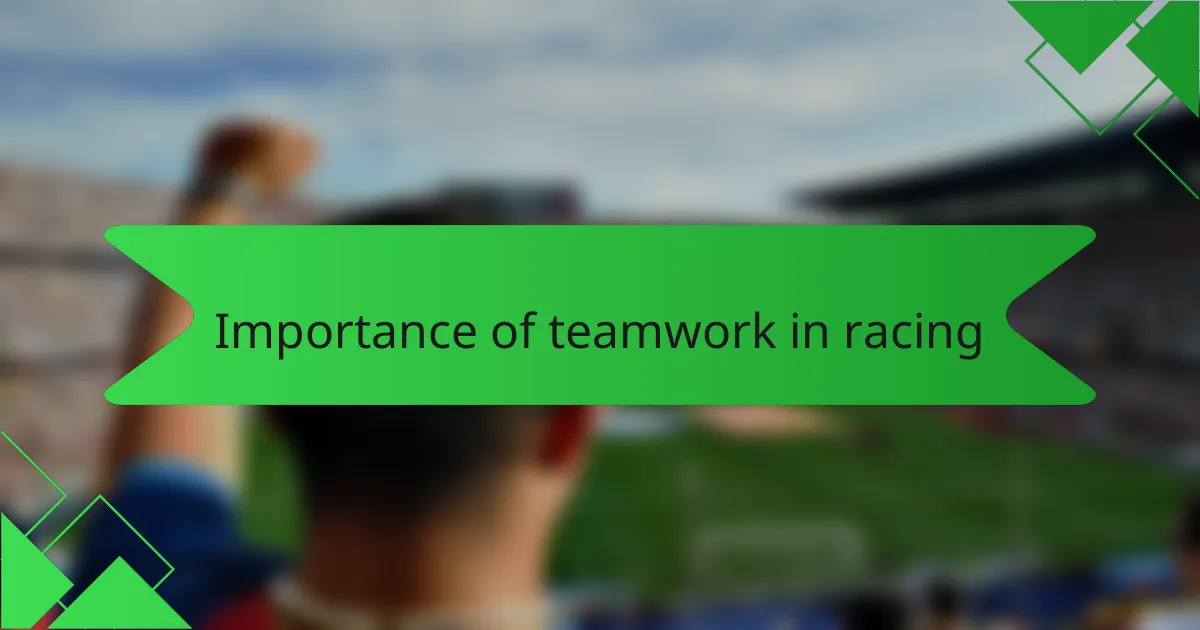Key takeaways
- Obstacle course racing combines physical and mental challenges, emphasizing strategy, pacing, and teamwork.
- Effective team communication and trust are essential for success in relay races, particularly during baton handoffs.
- Embracing teamwork enhances motivation and builds strong bonds among teammates, turning challenges into shared experiences.
- Adapting strategies based on individual strengths and maintaining open communication can help overcome race obstacles effectively.

Understanding obstacle course racing
Obstacle course racing is far more than just running; it challenges both the body and mind through a series of physical obstacles. I remember stepping into my first race, unsure if I could tackle walls, mud pits, and rope climbs, but the complexity of the course quickly made me realize it’s a test of endurance, agility, and grit.
What fascinates me most is how obstacle courses blend natural elements with man-made challenges. Have you ever felt the rush of conquering a slippery slope or swinging across monkey bars? That mix of fear and excitement keeps me coming back for more.
Understanding these races helped me appreciate how every obstacle demands strategy, not just strength. It’s a humbling reminder that success depends on pacing, technique, and sometimes, trusting your teammates to push through when your energy fades.

Basics of relay races
Relay races are all about teamwork and passing the baton smoothly while maintaining speed. From my experience in obstacle course relay races, the key is timing your handoff perfectly—too early or too late, and you risk losing valuable seconds. I’ve felt the adrenaline spike as my teammate approached, knowing that trust and coordination made all the difference.
Understanding the basics made me appreciate how each runner’s role fits into the bigger picture. Here’s what I learned as essential to relay racing success:
– Clear communication before and during the race
– Practicing baton handoffs to avoid drops and slow transitions
– Maintaining a steady pace to conserve energy for obstacles
– Encouraging teammates to keep morale high, especially during tough sections
– Being aware of each team member’s strengths to assign legs accordingly

Importance of teamwork in racing
Teamwork in racing isn’t just a nice-to-have; it’s the secret ingredient that can turn a good run into a great one. I’ve learned firsthand that when everyone trusts each other and works in sync, the race feels less like a solo battle and more like a shared adventure. Have you ever noticed how much smoother everything goes when your teammates are on the same wavelength?
What really struck me was how relying on others doesn’t mean losing control—it means multiplying strength. During one tough leg, I felt drained, but knowing my teammate was ready to take over gave me a boost I didn’t expect. That balance of individual effort and collective support makes all the difference when obstacles push you to your limits.
Isn’t it amazing how communication can change the entire dynamic of a race? Simple gestures or a quick encouraging shout kept our spirits high even in muddy, exhausting moments. From my experience, teamwork is the glue that holds everything together—it’s what turns physical challenges into unforgettable team victories.

Strategies for effective team communication
Effective team communication was a game-changer for me in relay races. I learned that clear, concise messages kept everyone in sync, especially when adrenaline was high and the course challenges were tough. I often used simple cues and frequent check-ins, which made the transitions smooth and boosted our confidence.
One thing I noticed is that active listening is just as important as speaking. When I truly paid attention to my teammates’ signals and concerns, I could adapt my pace and strategy without needing lengthy explanations. It felt like we developed an unspoken understanding that strengthened our teamwork under pressure.
| Communication Strategy | My Experience |
|---|---|
| Clear Instructions | Ensured smooth handoffs and prevented confusion during high-stress moments. |
| Active Listening | Helped me pick up on subtle cues and adjust quickly, avoiding mistakes. |
| Frequent Check-ins | Maintained team morale and kept everyone updated on race status. |

Personal experiences embracing teamwork
Personal experiences embracing teamwork must come from genuine moments on the course. For me, the shift happened during a grueling relay race where my usual solo pace was no longer enough. Sharing the load and encouraging one another transformed the experience from a tough challenge into an energizing journey. It made me realize how much stronger we are when we rely on each other’s strengths rather than trying to do it all alone.
| Before Embracing Teamwork | After Embracing Teamwork |
|---|---|
| Relying mostly on my individual speed and endurance | Coordinating strategies for each leg based on team members’ strengths |
| Feeling isolated and pressured to carry the entire race | Experiencing motivation and support with shared responsibilities |
| Focused on personal pace without considering others | Communicating constantly to adjust pace and overcome obstacles as a team |
| Limited sense of connection with teammates | Building strong bonds through collaboration and mutual encouragement |

Overcoming challenges in relay teams
Relay races in obstacle course racing come with unique hurdles, both physical and mental, that demand more than just individual skill. From my own experience, the hardest part wasn’t the obstacles themselves, but syncing with my teammates when fatigue and frustration set in. The moments when communication broke down almost cost us the race, teaching me the true value of patience and clear signals.
I learned firsthand that overcoming challenges in relay teams requires trust and adaptability. We had to adjust on the fly—whether it was helping a teammate stuck at a difficult obstacle or recalibrating our handoff timing after a slip. Here are a few strategies that made a difference for us:
- Establish clear communication before and during the race to avoid confusion.
- Support each other emotionally, especially when someone struggles or feels overwhelmed.
- Practice handoffs and transitions in advance to smooth out timing issues.
- Recognize individual strengths and assign legs of the race accordingly.
- Stay adaptable and ready to modify plans in response to unexpected obstacles or fatigue.
These lessons weren’t easy at first, but embracing teamwork in those moments turned a daunting race into an unforgettable experience.

Tips for successful relay race performance
When I first joined a relay race team, I quickly realized that success wasn’t just about individual speed but how well we synchronized. Timing our handoffs smoothly was crucial—I remember nearly dropping the baton once, and that moment taught me the value of clear communication and trust among teammates. Without that connection, even the fastest runner can falter.
Over time, I discovered several practical tips that boosted our performance and kept morale high. These strategies not only improved our race times but also made each leg feel less daunting because we knew we had each other’s backs.
- Practice handoffs repeatedly to build muscle memory and confidence.
- Establish clear communication signals during the race.
- Encourage each other with positive reinforcement.
- Assign legs based on each runner’s strengths and preferences.
- Maintain a consistent warm-up routine as a team to build camaraderie.
- Stay mentally present and support teammates, especially when challenges arise.
